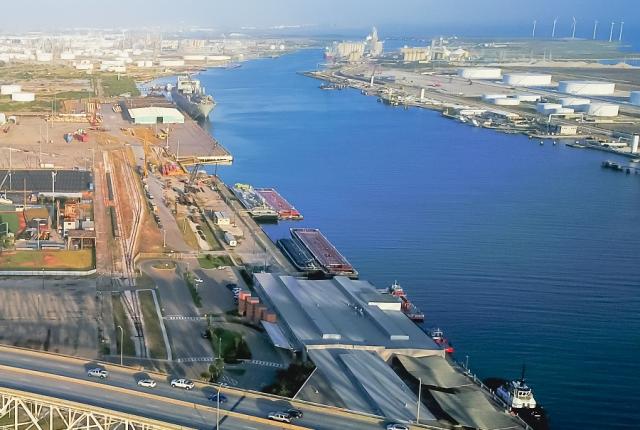
Canada’s Gibson Energy will expand its portfolio by buying South Texas Gateway Terminal, the second-largest oil export facility in the U.S., from Buckeye Partners and partners Phillips 66 Partners LP and Marathon Petroleum Corp. (Source: Shutterstock.com)
Canadian midstream oilfield service giant Gibson Energy is vastly expanding its infrastructure portfolio through a $1.1 billion cash acquisition of all membership interests in South Texas Gateway Terminal (STGT), the second-largest oil export facility in the U.S.
The transaction, announced June 14, connects Gibson to the Permian Basin and Eagle Ford shale through multiple, newly-built pipelines. The terminal that is less than three years old has two deep-water docks and 20 tanks that provide for terminalling capacity of 8.6 MMbbl of crude oil.
STGT is a newly built export facility, operating a deep-water, open-access marine terminal in Ingleside, Texas at the mouth of Corpus Christi Bay. The terminal achieved record volumes of more than 670,000 bbl/d of oil in March 2023. The terminal is a joint venture 50% owned and operated by Buckeye Partners. Phillips 66 Partners LP and Marathon Petroleum Corp. each hold a 25% ownership interest.
The transaction will put America’s largest liquids export terminals in the hands of Canadian companies; the Calgary, Canada-based Enbridge Inc. bought the Ingleside Energy Center from Moda Midstream for approximately $3 billion in 2021. The two terminals neighbor each other and are dominant in American oil exporting.
Gibson leaders heralded the deal as a massive boost to the company’s liquids-focused infrastructure and a move that will strengthen cash flow with more than 95% of revenue under take-or-pay contracts. The new terminal will maintain Gibson’s ESG profile by reducing the company’s carbon intensity, the company said, and it delivers immediate mid-teens discounted cash flow accretion.
Gibson CEO Steve Spaulding said that the transaction is a strategic fit that enhances his company’s scale and diversity.
“This transaction amplifies our high-quality infrastructure revenues and bolsters the continued growth of our distributable cash flow per share,” Spaulding said in a news release. “To add 1 MMbbl/d of export capacity and nearly 9 million barrels of terminals storage in a highly strategic location furthers our momentum in growing Gibson’s infrastructure footprint and provides a platform for future growth with existing and new customers.”
Sean Wilson, Gibson’s senior vice president and chief administrative and sustainability officer, told investors in a video that the company seeks to double in size in the next three to five years through organic growth and acquisitions.
“The STGT Terminal fits perfectly,” Wilson said in the video. Hinds Howard, portfolio manager at CBRE Investment Management who specializes in energy infrastructure, said the deal will advance Gibson far beyond its current infrastructure of mostly inland terminals in Canada.
“They have terminal experience and this deal should position the company to be a player in future developments around this asset like they have done in Hardisty up in Canada,” Hines told Hart Energy. “The deal increases their terminal capacity by 63%, making them a significantly larger company. The asset acquired is one of two Texas Gulf Coast crude export terminals capable of working with very large crude carrier capability ships.”
Pipelines that end at STGT include Gray Oak, Cactus II, Harvest and EPIC Crude.
The transaction, subject to closing adjustments, implies a multiple of less than 9x the projected forward adjusted EBITDA and is immediately accretive, with distributable cash flow per share accretion in the mid-teens, the Gibson release said.
Gibson plans to permanently finance the transaction with a $350 million deal offering of subscription receipts and with subsequent offerings of senior unsecured medium-term notes and hybrid debt securities. The company has secured commitments from bridge lenders and will launch an amendment to upsize its sustainability-linked revolving credit facility from $750 million to $1 billion. Sources of bridge funding for the transaction include JPMorgan Chase Bank and the Royal Bank of Canada.
Recommended Reading
Exxon Mobil, Chevron See Profits Fall in 1Q Earnings
2024-04-26 - Chevron and Exxon Mobil are feeling the pinch of weak energy prices, particularly natural gas, and fuels margins that have cooled in the last year.
California Resources Corp. Nominates Christian Kendall to Board of Directors
2024-03-21 - California Resources Corp. has nominated Christian Kendall, former president and CEO of Denbury, to serve on its board.
Imperial Oil Names Exxon’s Gomez-Smith as Upstream Senior VP
2024-04-30 - Cheryl Gomez-Smith, currently director of safety and risk at Exxon Mobil’s global operations and sustainability business, will join Imperial Oil in May.
CEO: Coterra ‘Deeply Curious’ on M&A Amid E&P Consolidation Wave
2024-02-26 - Coterra Energy has yet to get in on the large-scale M&A wave sweeping across the Lower 48—but CEO Tom Jorden said Coterra is keeping an eye on acquisition opportunities.
W&T Offshore Adds John D. Buchanan to Board
2024-04-12 - W&T Offshore’s appointment of John D. Buchanan brings the number of company directors to six.




